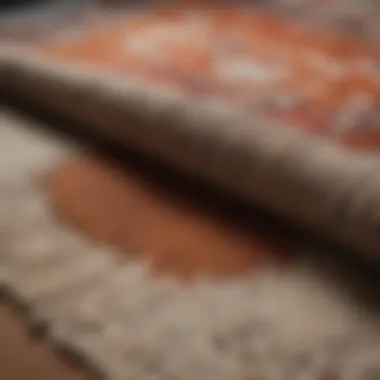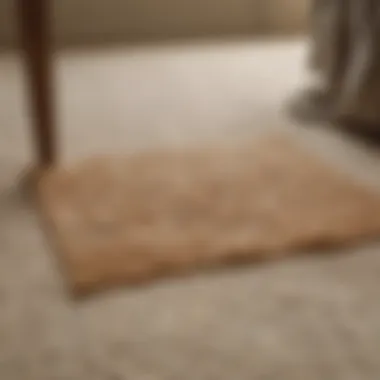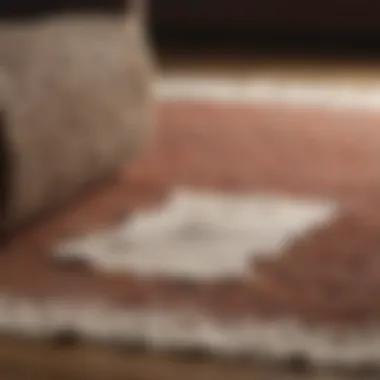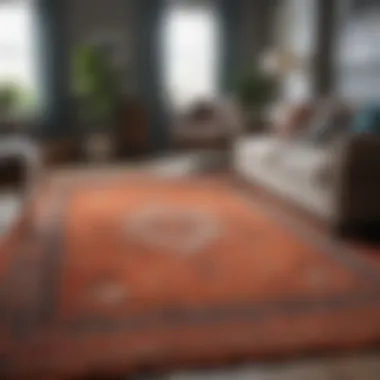Mastering Stain Removal Techniques for Wool Rugs


Intro
Wool rugs, known for their durability and aesthetic appeal, can often fall victim to stubborn stains. Understanding how to properly remove these stains is essential for maintaining the integrity and beauty of these decorative pieces. Whether it is a red wine spill during a cozy gathering or a pet accident disrupting your serenity, the right techniques can make all the difference.
This article dives into effective strategies for stain removal from wool rugs, targeting homeowners, interior design enthusiasts, and anyone invested in preserving their home’s elegance. We will explore the unique properties of wool, suitable stain removers, application techniques, and maintenance tips to keep your rugs looking pristine.
By equipping yourself with knowledge, you can handle stains with ease and confidence, ensuring your wool rugs remain visually stunning and structurally sound.
Design Inspiration
Incorporating wool rugs into your home design can enhance both warmth and sophistication. However, to maximize their impact, understanding current design trends can provide valuable insight.
Trending Styles
Various styles of wool rugs are making headlines in contemporary home design:
- Geometric Patterns: These rugs provide a modern touch, often featuring bold shapes and contrasting colors.
- Vintage and Distressed Looks: Aged rugs bring character to living spaces, complementing rustic or bohemian decor.
- Natural and Organic Textures: Handmade options that highlight the wool’s natural fibers appeal to eco-conscious consumers.
Color Palettes
Color selection can greatly influence the ambiance of a room. Popular palettes this season include:
- Earthy Tones: Soft greens, browns, and ochres create a warm, inviting atmosphere.
- Cool Neutrals: Shades of gray and beige can provide a calming backdrop, making spaces feel larger.
- Bold Accents: Vibrant reds or navy blues can dramatically uplift a room's energy.
Practical Tips
Taking care of your wool rugs goes beyond removing stains. Following a few practical tips can ensure lasting beauty and functionality.
Maintenance & Care
Regular cleaning routines are crucial to prevent dirt accumulation:
- Vacuum Regularly: Use a vacuum cleaner with a gentle setting to remove dust without damaging fibers.
- Spot Clean Immediately: Blot spills right away with a clean cloth to prevent absorption.
- Rotate Periodically: Change the orientation of your rug to avoid uneven fading due to sunlight exposure.
Budgeting & Planning
Investing in high-quality wool rugs should be paired with a clear budget and a plan:
- Assess the longevity and overall cost of maintenance when selecting a rug.
- Allocate funds not just for the initial purchase, but also for cleaning supplies and professional services if needed.
"An investment in a wool rug is multifaceted, representing both aesthetic appeal and future cleaning costs."
Implementing these design insights and maintenance tips will lead to enhanced experiences with your wool rugs. Being informed on the nature of wool and the right cleaning techniques will empower homeowners to respond effectively to stains, preserving the beauty and value of their rugs.
Understanding Wool Rugs
Understanding wool rugs is crucial for any homeowner or interior design enthusiast. These rugs not only offer warmth and comfort but also represent an investment in your home's décor. Knowledge about wool helps in appreciating its unique properties and suitability for various environments. This section will explore wool as a material and its common applications in interior designs.
Overview of Wool as a Material
Wool is a natural fiber, derived primarily from sheep. It has outstanding insulating properties, making it ideal for maintaining comfortable room temperatures. Its structure consists of natural crimp, which adds resilience and allows wool to flex without losing its shape. This flexibility makes wool rugs durable, allowing them to withstand substantial wear and tear. Furthermore, wool is naturally stain-resistant and has the capacity to absorb moisture without feeling wet, aiding in maintaining an attractive appearance.
Additionally, wool possesses a unique ability to repel dirt, which makes cleaning easier. For those concerned about allergens, wool is a solid choice as it can help to purify indoor air by absorbing harmful pollutants and releasing clean, breathable oxygen. Overall, understanding the fundamental properties of wool enhances your ability to maintain and care for these rugs effectively.


Common Uses of Wool Rugs in Interior Design
Wool rugs are popular in various interior design contexts due to their aesthetic versatility and functional benefits. They are often used in living rooms, bedrooms, and dining areas, contributing warmth and texture to these spaces. Their ability to blend with different styles, from contemporary to traditional, makes them a go-to choice for designers.
- Living Rooms: In these areas, wool rugs can serve as a focal point, tying together furniture arrangements and color schemes. Their rich texture enhances visual interest and comfort, making them ideal for gathering spaces.
- Bedrooms: Wool rugs add warmth and softness underfoot, providing a cozy atmosphere for relaxation. They are also popular for their sound-absorbing qualities, contributing to a serene environment.
- Dining Areas: Here, wool rugs can protect flooring while bringing together the dining experience. Their durability means they can handle spills, a common issue in these spaces.
The use of wool rugs transcends mere decoration; they enhance the overall functionality and comfort of a room. Being informed about their qualities and applications empowers homeowners to make choices that reflect their style while ensuring long-lasting beauty.
Why Stain Removal is Important
Removing stains from wool rugs goes beyond mere aesthetics. The importance of stain removal is multifaceted. It greatly impacts the life of the rug, the overall atmosphere of the space, and the health of the household.
Impact of Stains on Aesthetics
Stains on wool rugs can be highly noticeable, particularly against their natural colors and textures. A simple spill can turn into an unsightly mark if not addressed promptly. An unblemished wool rug adds elegance and sophistication to the space. When stains are left untreated, the beauty of the rug diminishes, affecting the overall interior design. Homeowners invest considerable amounts into quality wool rugs. Thus, maintaining their appearance is vital for showcasing the aesthetic value that these rugs bring to a room.
Moreover, guests often first notice the condition of the flooring. A stained rug can create a negative impression, making the entire environment feel unkempt. In contrast, clean and well-maintained rugs contribute positively to a welcoming atmosphere.
Wool Fiber Vulnerability
Wool itself is a resilient material, but it is not invulnerable to damage. Stains can penetrate the fibers, leading to discoloration and degradation. Wool rugs have a unique structure that can trap dirt and stains. If a stain is not addressed quickly, it can set into the fibers, making removal increasingly difficult over time.
Additionally, certain stains, such as those from acidic substances or dyes, can cause irreversible damage. The natural oils in wool may also be compromised, affecting the integrity of the rug. If care is not taken with stains, what may begin as a small mark can lead to larger issues. This, in turn, can lead to costly repairs or the need for complete replacement of the rug.
Maintaining a clean wool rug not only preserves its beauty but also protects the value of the investment.
Understanding why stain removal is crucial helps to recognize the ongoing care needed for wool rugs. It is about more than just removing visible marks; it involves protecting the material and maintaining the home’s aesthetic appeal.
Types of Stains Common to Wool Rugs
Understanding the types of stains that commonly affect wool rugs is crucial for effective cleaning. Each type of stain comes with its own set of challenges and requires specific strategies for removal. By knowing what you are dealing with, you can respond quickly and minimize damage to the delicate wool fibers. This section will cover three main categories of stains: food and beverage stains, pet-related stains, and ink and paint stains.
Food and Beverage Stains
Food and beverage stains are among the most frequent culprits for wool rugs. The nature of wool makes it susceptible to absorbing liquids and pigments found in various foods and drinks. Common offenders include coffee, wine, sauces, and fruit juices. The key to tackling these stains is prompt action. When a spill occurs, it is essential to dab the area with a clean cloth to absorb excess liquid. Avoid rubbing, as this can push the stain deeper into the fibers. After initial absorption, using a mild detergent mixed with water is often effective. Always test any cleaner on a small, inconspicuous area of the rug before proceeding.
Pet-Related Stains
Pet-related stains can be both challenging and unpleasant. Whether it’s urine, vomit, or mud, these stains can not only discolor the wool but also leave odors that linger. It is pivotal to address these stains quickly. For urine stains, a solution of white vinegar and water can help neutralize odors while lifting the stain. Applying this mixture should be done gently, allowing it to sit for a few minutes before blotting with a dry cloth. Make sure to rinse the area with clean water afterward. For mud, wait until it is completely dry before vacuuming. Then, a mixture of soap and water can assist in removing residue.
Ink and Paint Stains
Ink and paint stains present a different kind of challenge for wool rugs. They can set quickly, making immediate action important. For ink stains, a solution of rubbing alcohol can be applied carefully with a cotton ball. Blot the stain without rubbing to avoid spreading. In the case of paint, solvents specific to the type of paint (water-based or oil-based) may be necessary. Always refer to the manufacturer's instructions on cleaning best practices. Prioritize using minimal liquid to prevent further soaking of the fibers.
"Knowing the specific type of stain can significantly alter your approach to cleaning. Each requires tailored methods for the best results."
In summary, identifying the source and type of stains is fundamental in maintaining the beauty and integrity of wool rugs. By understanding common stains like food and beverage, pet-related incidents, and ink and paint, homeowners can act swiftly and effectively.
Choosing the Right Stain Remover
Selecting the correct stain remover is critical when it comes to maintaining wool rugs. The right product can make a significant difference in how effectively stains are addressed without damaging the rug fibers. It is essential to understand that wool is a delicate material. Choosing an inappropriate cleaner may cause discoloration or even degradation of the fibers.
Understanding Cleaning Agents


Cleaning agents function by interacting with stains in various ways. They can be categorized based on their formulation and intended purpose. Key types of cleaning agents include:
- Surfactants: These lower the surface tension between a liquid and a solid, helping to lift dirt and stains from surfaces.
- Enzymes: These break down complex substances such as proteins, which are often present in food and organic stains.
- Solvents: These dissolve stains from surfaces, particularly effective against oil-based substances.
Before applying a cleaning agent, it's crucial to inspect the rug and evaluate the stain type. This knowledge provides a foundation on which to build your cleaning strategy. Look for products specifically designed for use on wool materials, as each agent's effectiveness can vary based on the fibers involved. Always test a small, inconspicuous area first to ensure no adverse reaction occurs.
Natural vs. Chemical Cleaners
When it comes to choosing between natural and chemical cleaners, each has unique advantages and disadvantages.
- Natural Cleaners: These often consist of environmentally friendly ingredients. Common examples include vinegar, baking soda, and dish soap. They are generally safer for both the rug and the environment. Yet, they might not be as potent against stubborn stains compared to some chemical options.
- Chemical Cleaners: These products can provide powerful stain removal capabilities. Many chemical cleaners have specific formulations designed for various types of stains. However, caution is needed, as some chemicals can cause damage to wool fibers or affect color vibrancy. It's always advisable to check for certifications or endorsements that indicate safety for wool.
Ultimately, the choice between natural and chemical cleaners depends on personal preference and specific cleaning needs. Some homeowners opt for a combination approach, using natural cleaners for routine maintenance and chemical options for serious stains. Recognizing the suitability of each cleaner type enhances your ability to care for wool rugs comprehensively.
"Choosing the right stain remover is not just about immediate results; it’s also about preserving the integrity of your valuable wool rugs for years to come."
In summary, considering the nature of wool and the stains you face leads to more effective cleaning and longer-lasting rugs.
Step-by-Step Stain Removal Techniques
Stains on wool rugs can provoke dismay for many homeowners and design lovers. However, a structured approach to cleaning can minimize damage and restore beauty. Following a step-by-step method ensures a systematic handling of each stain, potentially enhancing the longevity of the rug. The aim is not only to remove the blemish but also to do so without compromising the integrity of the fibers. Thus, understanding the individual steps is crucial to effective stain removal.
Preparation for Stain Cleaning
Before diving into the actual cleaning, preparation is key. Having all necessary materials at hand helps to execute the process smoothly.
- Identify the Stain: Knowing the type of stain is essential. Food stains, pet-related stains, or ink require different approaches.
- Gather Cleaning Supplies: Common items include:
- Test the Stain Remover: Always conduct a small patch test before the main application. This procedure helps to ascertain that the cleaner does not alter the color or texture of the wool.
- Clean, absorbent cloths
- A soft brush or sponge
- Water for dilution
- Wool-safe stain remover, such as Woolite or Folex.
By preparing adequately, the risk of further damaging the rug while cleaning is greatly reduced.
Application of Stain Remover
When applying the stain remover, it's important to remain gentle and methodical.
- Blot, Do Not Rub: Place a clean cloth over the stain and press firmly to absorb as much liquid as possible. Rubbing can cause fibers to fray or bleed.
- Apply the Remover: Dampen a cloth with the stain remover and blot it on the stain, allowing it to penetrate. Avoid saturating the rug as excess liquid can seep into the backing.
- Work from the Outside In: Always approach the stain from the perimeter toward the center. This practice prevents the stain from spreading further.
- Follow the Directions: Adhere to specific instructions provided with the stain remover for optimal results.
Using these techniques ensures that the application is effective and reduces the likelihood of residue being left behind.
Finalizing the Cleaning Process
Once the stain has been treated, it is crucial to complete the cleaning process properly.
- Rinse with Cold Water: Lightly dampen a clean cloth with cold water and blot the treated area to remove any residue from the cleaner.
- Dry the Area: Use a dry towel to absorb excess moisture. Air-drying is preferred, as using heat can distort the fibers.
- Fluff the Rug: Once dry, if necessary, gently brush the fibers to promote their original texture.
- Evaluate the Result: Inspect the treated area to ensure the stain is wholly removed. If remnants remain, repeat the process as needed.
By concluding the cleaning process with these final touches, the wool rug will return to its optimal condition.
Preventative Measures for Stains
Preventative measures for stains are a critical component of maintaining the beauty and longevity of wool rugs. By understanding and implementing these strategies, homeowners can significantly reduce the likelihood of stains becoming a permanent issue. Regular care and attention not only preserve the aesthetic appeal of wool rugs but also extend their lifespan. When you take proactive steps, you minimize the need for aggressive cleaning methods that could potentially damage the fibers.
Routine Maintenance Practices


Routine maintenance is essential for keeping wool rugs in good condition. Regular vacuuming is the first line of defense against dust and dirt that can settle into the fibers. Using a vacuum with a suction option, rather than a beater bar, will help avoid damaging the delicate wool.
Here are some key practices to consider:
- Frequent Vacuuming. Aim to vacuum at least once a week to keep the surface clean. This removes loose dirt and debris that can cause staining if left untreated.
- Rotation. Regularly rotate the rug to ensure even wear from foot traffic. This helps prevent any particular area from becoming more stained than others.
- Immediate Attention to Spills. If a spill occurs, act fast—dab the area with a clean cloth to absorb as much of the liquid as possible. Avoid rubbing as this can spread the stain further.
Maintaining clean rugs creates a more inviting atmosphere in your home. It shows attention to detail and enhances the indoor environment, aligning with the desires of homeowners and design enthusiasts alike.
Using Stain-Resistant Treatments
Applying stain-resistant treatments is another effective strategy to protect wool rugs from potential stains. These treatments create a protective barrier over the fibers, making it easier to clean up spills before they set into the fabric.
Consider the following aspects when selecting and using stain-resistant treatments:
- Choose Wisely. Look for eco-friendly products specifically formulated for natural fibers such as wool. Brands like Scotchgard offer treatments that safeguard against spills while being safe for home use.
- Application Method. Follow the product's instructions carefully. Typically, you will need to apply the treatment in a well-ventilated area, ensuring an even distribution.
- Regular Reapplication. Over time, the effectiveness of these treatments may diminish. Schedule regular reapplications, perhaps once a year, to maintain the protection level.
Implementing these stain-resistant treatments not only protects wool rugs but also makes cleaning easier, as stains lift off the surface more easily. Homeowners can enjoy their space without the lingering worry of accidental spills affecting their wool rugs. Ultimately, investing time in preventative measures helps ensure the beauty and integrity of these luxurious floor coverings.
Professional Cleaning Services
Engaging a professional cleaning service can be a valuable consideration when dealing with stain removal on wool rugs. Wool fibers are delicate and require specialized care. Using the wrong techniques or cleaning agents can lead to further damage or even irreparable harm. Professional cleaners possess the expertise and tools necessary for effective treatment without compromising the integrity of the rug. Furthermore, they can often address stains that may seem impossible to remove, offering solutions that maximize the rug's lifespan and preserve its aesthetic value.
In addition to their technical skills, professionals can provide insight into the ongoing maintenance of the rug. They can guide homeowners on how to care for the rug post-cleaning, helping to avoid future stains and retain the original beauty of the fiber. Seasonal cleanings can also prevent dirt and allergens from accumulating, making it beneficial for households with pets or allergies.
"Investing in a professional service can save you time, efforts, and potentially the rug itself."
When to Consider Professional Help
There are specific instances when it becomes crucial to seek professional help for wool rugs. If the stain is extensive or particularly stubborn, such as large food spills or dye from ink, experts can address these challenges effectively. Additionally, if there is a combination of stains present, this can complicate the cleaning process. Multiple stains may require different cleaning strategies that a trained professional is best equipped to handle.
Another key factor is the rug's value and sentimentality. If the rug is an heirloom or a significant investment, it makes sense to enlist a professional. Their knowledge of advanced cleaning techniques can facilitate effective stain removal and overall maintenance, ensuring the rug remains in excellent condition for years to come.
Selecting a Reputable Cleaning Service
When choosing a professional cleaning service for wool rugs, it is essential to conduct thorough research. Start with recommendations from trusted sources. Friends or family can share their experiences, and online reviews can provide insights into service quality. Look for companies that specialize in the cleaning of wool or delicate fabrics, as they will be more attuned to the specific needs of your rug.
Consider the following criteria while selecting a service:
- Experience and Expertise: Ensure the company has a solid track record in rug cleaning, particularly with wool.
- Certifications: Look for industry certifications that demonstrate technical knowledge and adherence to best practices.
- Methods Used: Inquire about the cleaning methods they employ, focusing on those that are safe for wool.
- Customer Service: Assess their responsiveness and willingness to address any of your concerns before making a commitment.
In summary, using a professional service when needed can significantly benefit wool rug maintenance. It's always better to err on the side of caution when dealing with cherished textiles.
Closure
In this article, the importance of effective stain removal from wool rugs has been emphasized throughout. Stains can drastically affect the appearance and value of such rugs, making timely and proper care essential. Understanding the unique properties of wool fibers is crucial to choose the right cleaning techniques and products that protect the material while effectively removing stains.
Summary of Key Insights
A few points stand out from the information presented:
- Wool's Vulnerability: Wool rugs can absorb liquids and stains quickly. This means that immediate action is necessary to prevent permanent staining.
- Types of Stains: Different stains may require different removal strategies. Food and beverage stains differ from pet-related or ink stains in their cleaning approach.
- Selection of Products: Knowing when and how to use specific stain removers can make the cleaning process more effective without damaging the fibers.
- Professional Services: Sometimes, it is better to leave tough stains to experts who have access to specialized cleaning solutions.
- Preventative Measures: Regular maintenance routines and treatments can significantly reduce the frequency of stains.
"Effective care not only maintains the aesthetic appeal but also extends the lifespan of wool rugs."
Encouragement for Care and Maintenance
Taking care of wool rugs should not feel overwhelming. By following a steady routine, homeowners can keep their rugs in excellent condition. Simple actions like regular vacuuming, quick blotting of spills, and periodic deep cleaning can prevent minor issues from becoming significant problems.
Investing time in understanding the nature of wool and using the right strategies will pay off in the long run. Wool rugs are beautiful and can be a lasting element in home design if cared for correctly. Embrace the responsibility of maintaining wool rugs, and you will enjoy their beauty and functionality for many years to come.















